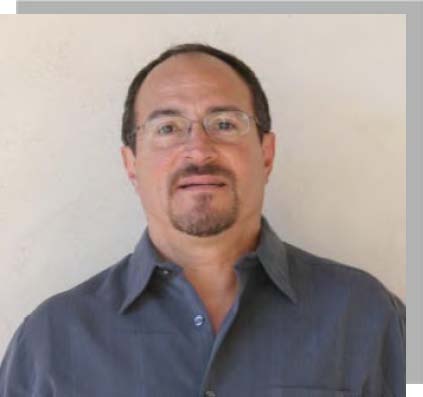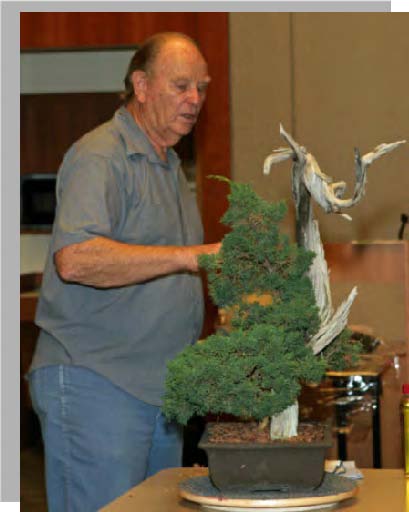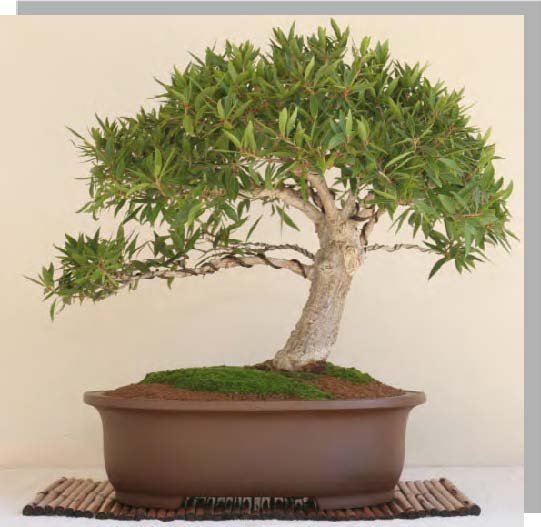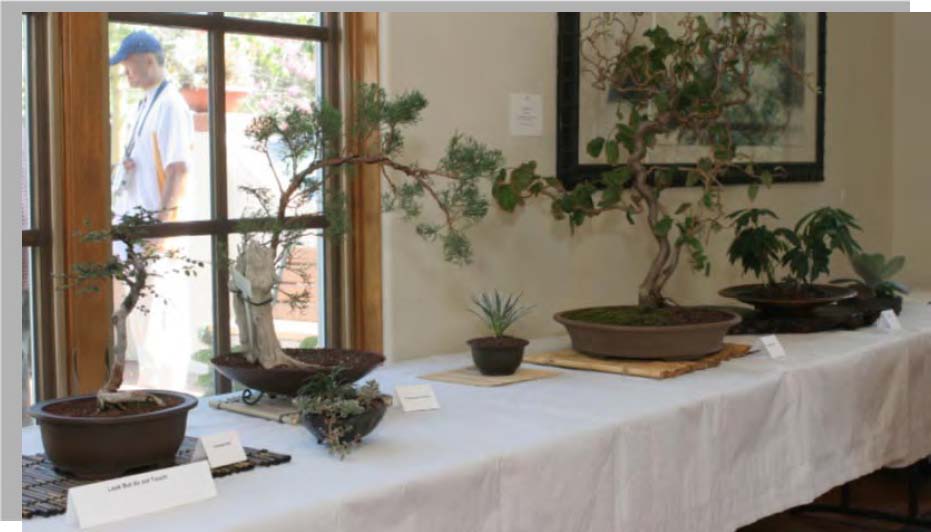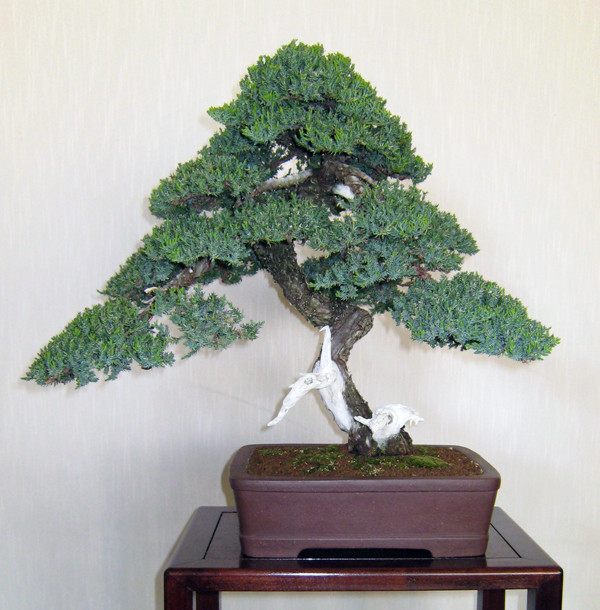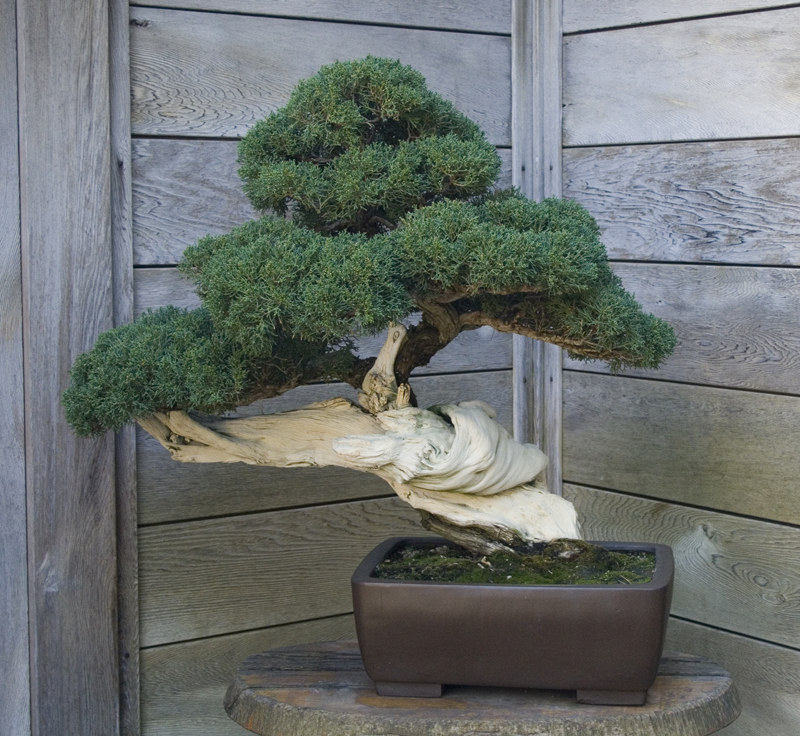October 2008 Newsletter
President’s Message
Our Best Show to Date
By Ken Fuentes
Congratulations to everyone who participated in our 5th Annual Bonsai Exhibition at Gardens of the World October 4 – 5 on a great team effort. Thanks to all of you, our show was a huge success.
|
Our focus as a group was visible in the cleanliness of the trees, of the containers, and in the display. A special thanks to all members who provided material, shared stands and accent plants, and took shifts working the Exhibition.
This year for the first time we were invited by the Ventura County Japanese American Citizens League to exhibit our bonsai at their festival. This show was their 18th Annual “Japanese Culture Day” and was held on Sunday, October 12, at the Camarillo Community Center. This annual event drew hundreds of visitors. We hope to see some new members from this show.
Your club’s officers selected 18 of the best bonsai from our Gardens of the World exhibition to represent us at the Japanese Culture festival. Not having previous experience at this venue we can only go by comments that were made to us by organizers of the show. They were very pleased and were impressed with our display. This success is also a direct result of everyone’s focused effort for our own show.
Our October’s meeting is a general workshop, so please bring in any trees that we have already worked on for updates and any new material that needs styling.
Thanks again to everyone who pitched in to meet the “Presidential Challenge” made in August and September by putting in your best effort to make this year’s show a success.
Club Events
Preparation Leads to Exhibition
By David E. Whiteside
This year’s annual Exhibition at Gardens of the World was delivered with a one-two-three punch. The first punch was our Au-gust meeting at which Conejo Valley Bonsai Society members brought bonsai they hoped to enter in the Exhibition for a review by our officers and advanced practitioners. Second was our September meeting, where bonsai professional and teacher Jim Barrett gave those trees a second review, making practical suggestions both for individual bonsai and for the show. And the show, of course, was the third punch.
|
This month we take a quick look at some of Jim Barrett’s suggestions, a photographic overview of the Exhibition, and a few individual bonsai at the show.
Jim started with some general observations about preparing bonsai for a show.
-
Step one, he said, is to groom and fine tune the tree at the last moment—a few days before the show. He cautioned us not to rewire the whole tree or make other major changes. And while it is considered okay to have wire on small branches, it’s best to avoid having any heavy wire on the trunk or main branches. (But he pointed out that if there is a novice section, these guidelines are often relaxed because beginners often have not had enough time for their trees to mature.)
-
Another key issue is the color of foliage, which above all should be healthy looking. Our Exhibition is in the fall, so on deciduous trees, some color—even a bit of brown—would be appropriate (but not a bunch of dead leaves that don’t show fall color; they’d just look unhealthy). And on junipers, color can be enhanced by spraying the tree with horticultural oil a day or two before the show. Not only will the oil bring out the green, it’s good for the tree.
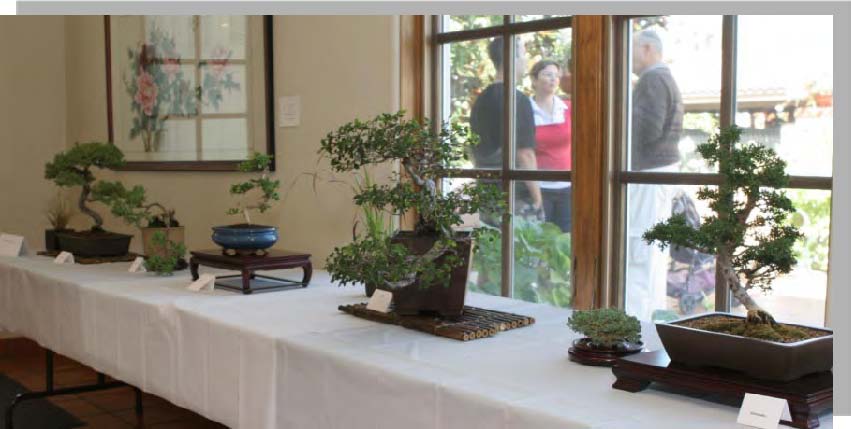
Photo 2: CVBS members Marj Branson’s (the two on the right) and Bob Stradling’s bonsai on the display in the Resource Center at Gardens of the World.
-
One way to enhance the illusion of age is to place moss on the soil. Jim suggested it be put on radiating out from the trunk and emphasized that it must be made to look natural, as if it has grown there for a long time by pressing down on the edges so they grip the soil.
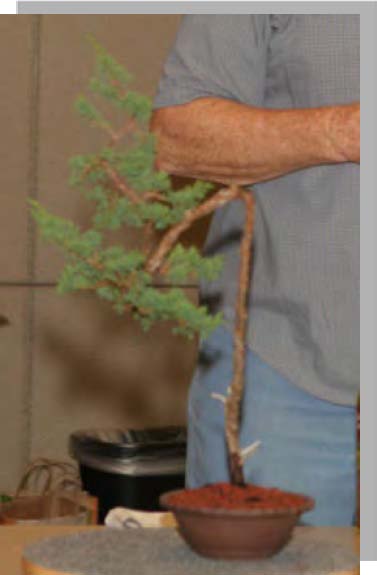
Photo 3 – 4: Al Espinoza’s bunjin-style Shimpaku Juniper as it appeared at our september meeting (above) and at our Exhibition (below), with moss radiating from it’s trunk and on a circular wooden stand.
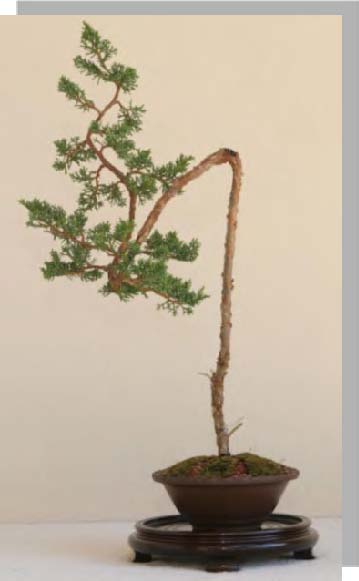
-
Moss on the trunk, however, should be removed for the health of the tree, especially species that have rough bark.
-
For a show, pots must be clean and free of any lime, scale, or water spots. For unglazed brown pots, Jim suggests using something like a bathroom cleaner to get as much off as possible, and then apply an oil such as lemon oil to cover up the rest of the marks. After applying the oil, he emphasized, it’s important to buff the pot with a clean cloth to bring out the deep brown color.
-
Chipped pots normally are considered a problem, so the tree should have been potted with the chip(s) at the rear, out of sight. But if the pot is old or antique, the chip may be considered a “beauty mark” and placed in the front.
-
If your show trees have deadwood (jins, sharis, drift-wood, etc.), about two weeks before the event, Jim recommended applying lime sulfur to bleach the wood. To keep it from looking too white and artificial, a bit of India ink or dark water color can be added to the lime sulfur to yield a more grey color.
-
In an exhibition, bonsai must be placed on some sort of stand. As an alternative to expensive commercial bonsai stands, Jim urged us to be somewhat creative. Pieces of redwood, flag-stone, bamboo mats, and so forth would be fine, he said: “Don’t just plunk the tree down, put it on something!”
-
Companion or accent pieces can be another plant such as blood grass (especially in winter shows), an interesting rock, perhaps a suiseki (a.k.a., scholar’s rocks, viewing stones, etc.)—but beware of using expensive items, Jim warned, because “they tend to disappear.”
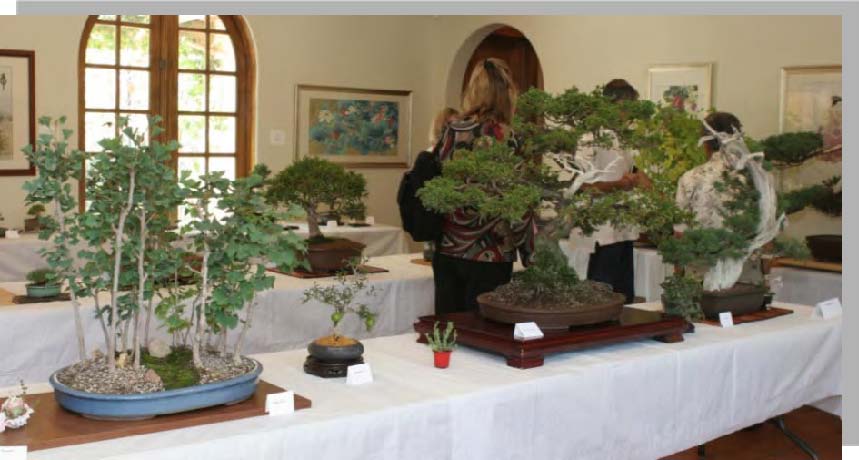
Photo 5: A table full of CVBS members’ bonsai in the Resource Center. Kevin Keily’sGinkgo forest is on the left, Bob Mora’s large San Jose Juniper is in the middle, and Kevin’s Shimpaku tanuki is at the far right.
It was clear at the October 4 – 5 Exhibition that many members followed Jim’s advice. Al Espinoza, for example, added moss radiating out from the trunk of his bunjin-style Shimpaku to good effect (see photos 3 – 4). And he told this author to hide the grey/white soil in my Willow
|
Leaf Ficus’s pot with something that looked more like a natural soil. I chose to cover it with a combination of a hard-baked clay substance called Turface MVP and moss that I grow in trays (see photo 6).
And it is worth noting that there actually was a fourth “punch”: The Ventura County Japanese American Citizens League invited our club to exhibit our bonsai at their annual Japanese Culture Day festival in the Camarillo Community Center on Sunday, October 12. Our officer’s selected 18 trees from our own Exhibition that they felt would represent us well at the Japanese Culture Day. We put together a very good exhibit for them—and the festival organizers were very complimentary, declaring our show significantly better than previous bonsai exhibits they have had.
|
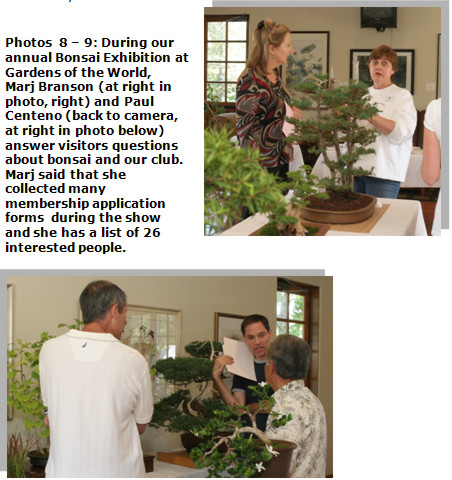
Barrett’s Bonsai Tips
October: Clean Up, Rewire, Pot / Repot, and More
By Jim Barrett
October is a very good month to clean up Japanese black pine and junipers.
If you have black pine bonsai, finish pruning the unwanted new growth leaving one, two, or three new candles on the tips of each branch or twig that was pruned earlier this summer. How many candles you leave is determined by your design goals for the tree [and] whether the new growth is on the outer limits of the tree or in the interior.
|
Old needles (discolored) should be removed. New or fresh needles should remain until December or January. Leaving these new healthy needles on through the fall should keep the tree at its best.
Cutting long needles shorter will allow sunlight to penetrate into the interior of the trees, and help to build stronger growth on the weak and stunted interior candles and twigs.
Junipers may be cleaned of all dead or discolored foliage. Prune the “hanger downers” and the “pointer uppers” unless you plan to wire them into a more horizontal position.
October is also a good time to remove old wire and rewire for detail.
You should be able to prune quince, apple, and Ume for shape now and place them into their show pots, if this is a practice you follow.
Fertilize azaleas and most flowering and fruiting bonsai with low nitrogen, high phosphorous fertilizer. A 0-10-10 should work well.
Remember to start choosing those show trees for next year. Keep your eyes open for quality pots you may wish to use for these trees.
Repotting and potting (from nursery container to bonsai pot) can be safely done at this time for black pine and most junipers. Repotting flowering and fruiting bonsai from bonsai pot to bonsai pot can be done, provided the root ball is not drastically disturbed and the tree is reasonably healthy.
Pay attention to watering schedules this month and next. Keeping plants too wet may promote root rot, especially if the tree is not actively growing. Watch for fungus, spider mites, and scale.
Program Notes
2009 Is Taking Great Shape
By David E. Whiteside
For the remainder of 2008 and the first four months of 2009, we have some exciting plans. First, we will continue our big push to have members bring trees to our workshop meetings—there are four of them from October this year through April 2009. Working on our bonsai together, sharing ideas, learning from each other, and tapping the brains of our most experienced members is at the core of the Conejo Valley Bonsai Society experience.
In addition to these workshops, Program Chair Deborah Ervin already has two of the best-known, respected, and popular bon-sai “gurus” lined up for us. Kicking off the 2009 series of demonstrations, Ted Matson will be our guest presenter at the February 19 meeting. Two months later, Kathy Benson will be our guest demonstrator. It’s quite an accomplishment to have these two leading off our year. Ted Matson, for example, is so popular he’s booked solid more than a year ahead.
The current lineup is below. As Debbie fleshes out the rest of 2009, we’ll add to the program box score.


